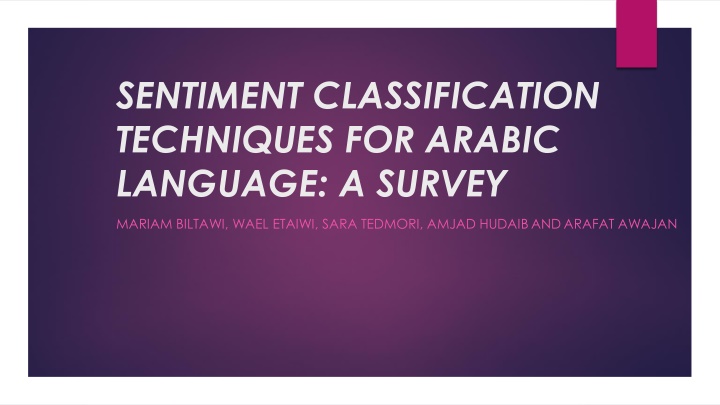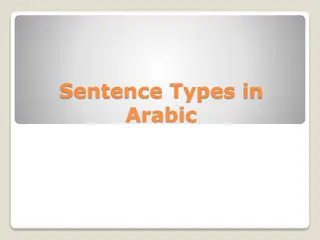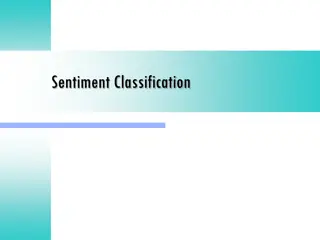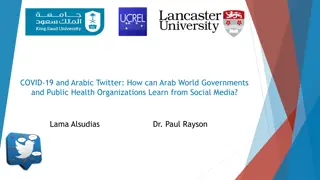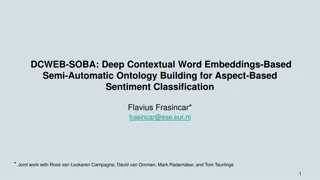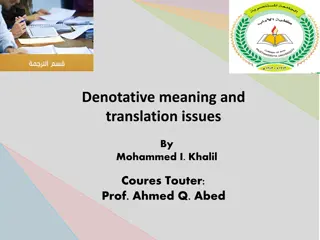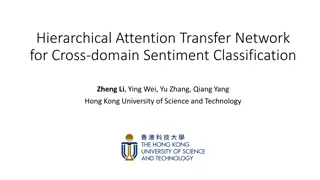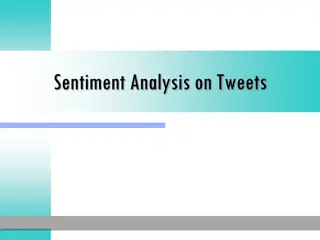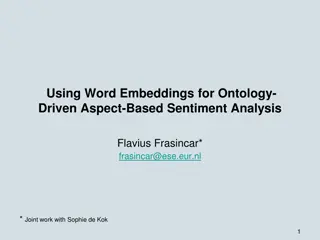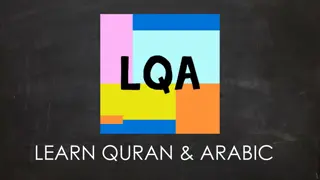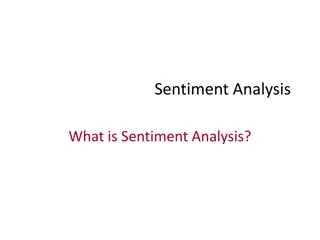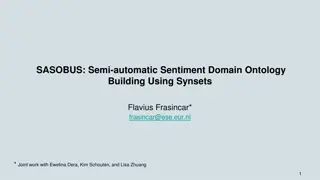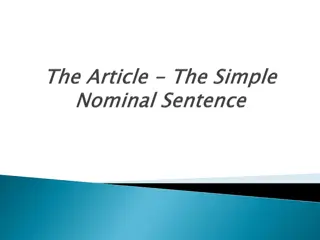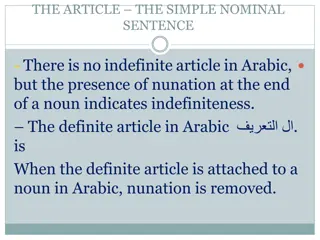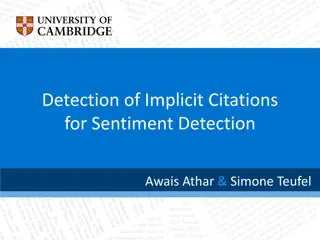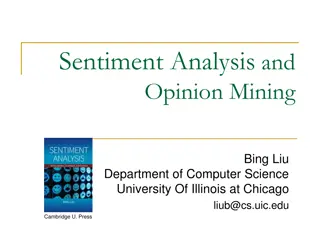Survey of Sentiment Classification Techniques for Arabic Language
Sentiment analysis aims to determine sentiment orientation towards a specific entity. This paper provides a comprehensive survey of machine learning and lexicon-based sentiment classification techniques for the Arabic language, covering topics like corpora, lexicons, and machine learning classifiers.
Download Presentation

Please find below an Image/Link to download the presentation.
The content on the website is provided AS IS for your information and personal use only. It may not be sold, licensed, or shared on other websites without obtaining consent from the author.If you encounter any issues during the download, it is possible that the publisher has removed the file from their server.
You are allowed to download the files provided on this website for personal or commercial use, subject to the condition that they are used lawfully. All files are the property of their respective owners.
The content on the website is provided AS IS for your information and personal use only. It may not be sold, licensed, or shared on other websites without obtaining consent from the author.
E N D
Presentation Transcript
SENTIMENT CLASSIFICATION TECHNIQUES FOR ARABIC LANGUAGE: A SURVEY MARIAM BILTAWI, WAEL ETAIWI, SARA TEDMORI, AMJAD HUDAIBANDARAFAT AWAJAN
Abstract Sentiment analysis aims to determine the overall sentiment orientation of a speaker or writer towards a specific entity or towards a specific feature of a specific entity A fundamental task of it, is sentiment classification, which aims to automatically classify opinionated text as being positive, negative, or neutral. The main goal of this paper is: To provide a comprehensive survey of existing machine learning and lexicon based sentiment classification techniques for Arabic language
Content Introduction Sentiment Analysis Corpora and Lexicon Lexicon-base approach Machine learning classifiers Discussion Conclusion
Corpora and Lexicon The supervised and lexicon-based techniques for SC are dependent on having either a corpus or a lexicon. A corpus is a dataset of labeled reviews or text that is used by the supervised technique to train classifiers in order to predict the sentiment of unseen reviews. A lexicon is a dictionary of words labeled with its sentiment value as positive, negative or neutral. The hybrid technique tries to enhance the accuracy of the classifiers using lexicon.
Corpora and Lexicon Available Lexicons: ArSenL: large-scale Arabic Sentiment Lexicon is the first publicly available lexicon, constructed using a combination of English SentiWordnet (ESWN), Arabic WordNet, and the Arabic Morphological Analyzer (AraMorph). SLSA: Standard Arabic Sentiment Lexicon is another publicly available lexicon, constructed by linking the lexicon of AraMorph with SentiWordNet along with a few heuristics and powerful back-off.
Corpora and Lexicon Available Corpora s: ASTD: The Arabic social sentiment analysis dataset, consists of 10000 Arabic tweets, manually classified into objective, subjective positive, subjective negative, and subjective mixed. AWATIF is a multi-genre, multi-dialect manually built corpus for Arabic Subjectivity and SA, extracted from three different resources: the Penn Arabic Treebank (PATB), Wikipedia user talk pages, and conversation threads from web forums of seven different sites. LABR: the Large-scale Arabic Book Review dataset which consists of over 63,000 book reviews each with a rating of 1 to 5 stars. HAAD: The first aspect-based SA dataset for Arabic language is human annotated Arabic dataset (HAAD), consists of human annotated Arabic books reviews with aspect terms and their polarities.
Lexicon-base approach Lexicon-based SC: an unsupervised approach, consists of two main categories; dictionary-based, corpus-based
Machine Learning Classifiers Machine Learning classifiers Probabilistic Classifiers Na ve Bayes (NB) Maximum Entropy Classifier (ME) Linear Classifiers Decision Tree Classifiers Rule-Based Classifiers
Table of Articles Summary Table 1 : Articles summary Domain- Oriented Year Task Algorithm-Used Polarity Data Scope Type Accuracy Ref. Arabian scientific encyclopedia/ prophetic traditions or 'Hadiths' 2009 SA N Decision Tree classifiers G MSA scientific corpus: 93% literary corpus: 91% [31] grammatical approach: 89.3% semantic Approach: 62% document level approach: 87% N/A 2010 SC N Dictionary-based Pos/Neg Arabic movies MSA [17] 2010 SA N Corpus-based Pos/Neg Arabic Business Reviews Arabic [18] SVM, NLP and Bayes Point Machine (BPM) 2010 SA Y Pos/Neg Hadith MSA 96% [30] 2011 SA N Corpus-based Pos/Neg Newswire MSA N/A [22] Arabic Facebook Posts (Social Networks) Na ve Bayes: 83.4 % Na ve Search: 91.2% 2012 SC N Probabilistic classifier Pos/Neg Syrian, Egyptian, Iraqi and Lebanese dialects, [24] Pos/Neg 2012 SA N Probabilistic Classifiers Arabic news text MSA 29.93 % - 85.52 [26] 2012 SC N ML Pos/Neg Arabic Twists MSA / Colloquial Arabic. 72.6% [35] MSA/Egyptian, Iraqi, Jordanian, Lebanese, Saudi, Syrian Dialects 2013 SA Y Dictionary-based Pos/Neg 72 social and news sites 90% [13] Pos/Neg Arabic youth news comments on Facebook 2013 SC Y Linear Classifiers Arabic slang language 88.63% [28] Pos/Neg 2013 SA N Rule-based Classifiers Arabic movie reviews, MSA N/A [33] 2014 SA N Dictionary-based Pos/Neg Maktoob/ Twitter MSA/Different Dialects 74.6% [12] subjectivity algorithm: 93.9% polarity algorithm: 90% Strength/ Intensity Algorithm: 96.6% 76.78% G MSA/ Egyptian, Iraqi, Jordanian, Lebanese, Saudi, Syrian Dialects 2014 SA Y Dictionary-based 72 social and news sites [14] Pos/Neg 2014 SA N Corpus-based Pos/Neg Arabic Tweets MSA/ Jordanian dialect/ Arabizi [20] ML (NB, k-nearest neighbor (KNN) and SVM) Pos/Neg MSA / 2014 SA N Arabic Twists and comments NB: 66.20 % SVM: 75.25% KNN: 70.97% [25] Colloquial Arabic. ML (decision tree, SVM and NB) 2014 SA Y Pos/Neg Arabic YouTube pages N/A 94.5% [32] Pos/Neg MSA / 2014 SA N Rule-based Classifiers Arabic documents 21% - 57% [34] Colloquial Arabic. Arabic Tweets/ Product reviews/ TV Program Comments/ Hotel Reservation 2015 SA N Corpus-based Pos/Neg MSA/ Egyptian Dialect 95% [19] 2015 2015 2015 SA SA SA N N N Dictionary-based Corpus-based NLP Pos/Neg Pos/Neg Pos/Neg Arabic Tweets Arabic Tweets Arabic Reviews Arabic 67.3% 66.57% N/A [21] [23] [15] Syrian Dialect MSA MSA/ Egyptian, Iraqi, Jordanian, Lebanese, Saudi, Syrian Dialects 2015 SC Y NLP Pos/Neg Arabic Text 69.3% [16] Bagging Technique: 85.95% Boosting Technique: 69.25% 2015 SA Y ML Pos/Neg Arabic tweets (textual & Audio) MSA / Colloquial Arabic. [27] Excellent, very good, middling, weak and horrible comments collected from Trip Advisor website 2015 SA Y Linear Classifiers MSA N/A [29]
Conclusion About 24 papers were surveyed SC were categorized into three main techniques; the lexicon-based, ML and hybrid techniques. The interest in Arabic language processing raised in the last 5 years. Twitter is the most frequently used data source in Arabic SA The most common ML algorithms used to classify Arabic sentiments are NB and SVM. Arabic SA and SC are still an open area for research.
Thank You MARIAM BILTAWI , WAEL ETAIWI
